Exhibition dates: 13th May 2017 – 28th January 2018
Location: Terminal 2 Departures – Level 2 – Post-Security
Solomon D. Butcher (American, 1856-1927)
Portrait of Professor C.W. Roush, principal of the Broken Bow Business College, and his stenographer, Miss Mable Holcomb
1903
Collection of Nebraska State Historical Society
NB. Note the use of Remington Standard Typewriter No. 6
Solomon D. Butcher (January 24, 1856 – March 18, 1927) was an itinerant photographer who spent most of his life in central Nebraska, in the Great Plains region of the United States. A settler under the Homestead Act, he began in 1886 to produce a photographic record of the history of white settlement in the region. Over 3,000 of his negatives survive; more than 1,000 of these depict sod houses. Butcher wrote two books incorporating his photographs: Pioneer History of Custer County and Short Sketches of Early Days in Nebraska (1901), and Sod Houses, or the Development of the Great American Plains (1904).
Butcher was unable to achieve financial success as a farmer, as a photographer, or in a number of other schemes later in his life, and at the time of his death felt that he had been a failure. However, the number and scope of his photographs of Nebraska pioneer life have made them a valuable resource to students of that period of history, and they have become a staple of historical texts and popular works alike. His oeuvre has been described as “the most important chronicle of the saga of homesteading in America”.
Text from the Wikipedia website
I LOVE TYPEWRITERS!
They may be obsolete technology, but boy do they have great design and so much style.
What a collection of machines… so many rare models in this exhibition.
Portable typewriters, folding typewriters, QWERTY keyboards (still with us), and the names: Royal Deluxe, Torpedo, and the Corona No. 3 Special. It sounds like a cigar, but that’s the one I would take home. Plus the Oliver Typewriter Company “Oliver 3” … the one with “wings” in the installation photographs of the first case.
A marvellous collection so well brought together in this exhibition. Congratulations to all involved.
Dr Marcus Bunyan
Many thankx to Daniel Calderon, Chad Anderson and the SFO Museum for allowing me to publish the photographs and text in the posting. Please click on the photographs for a larger version of the image.
@SFOMuseum #TheTypewriter
Installation views of the exhibition The Typewriter: An Innovation in Writing at the SFO Museum, San Francisco International Airport
Installation view of the exhibition The Typewriter: An Innovation in Writing at the SFO Museum, San Francisco International Airport with the Sholes & Glidden Type Writer (left) and Remington Standard No. 12 (second left)
Sholes & Glidden Type Writer
1875
E. Remington & Sons
Ilion, New York
Anonymous lender
Sholes & Glidden Type Writer
The Sholes & Glidden Type Writer ushered in a new era of communication technology. Invented by Christopher Latham Sholes (1819-1890) with assistance from Samuel Soulé (1830-1875) and Carlos Glidden (1834-1877) in Milwaukee, Wisconsin, it was the first commercially produced typewriter with hinged type-bars and a four-row keyboard. In 1873, the Type Writer introduced “QWERTY,” a keyboard layout named for the first six letters at the top-left row of letter keys. Organised to prevent type-bars from clashing and jamming prototype machines, QWERTY was mechanically suited to the Sholes & Glidden and not necessarily designed for efficient typing. Contemporary computers, tablets, and smart phones share the QWERTY keyboard layout.
Remington Standard No. 12
1927
Remington Typewriter Company
Ilion, New York
Type-O-Meter conversion c. 1938
General Coin Automatic Co. San Francisco
Collection of Joe Welch American Antique Museum
Industry
Advances in industry and business made the typewriter both possible and indispensable. Early typewriter factories combined recently developed processes such as steel stamping and zinc plating with aluminum, cast iron, vulcanite, and other new materials into their assembly lines. At the same time, typewriters created massive amounts of paperwork to support increased organisation and communication in manufacturing and business. By the 1930s, the typewriter was such a commercial success that even coin-operated conversions were offered.
Installation view of the exhibition The Typewriter: An Innovation in Writing at the SFO Museum, San Francisco International Airport with the Hammond 1b (left) and Crandall New Model (centre)
Hammond 1b
c. 1890
The Hammond Typewriter Company
New York
Anonymous lender
Type-shuttles
During the 1880s, a multitude of patents for new typewriter designs were introduced. One of the most innovative was invented by James B. Hammond (1839-1913), a Civil War correspondent who became frustrated as news press staff misinterpreted and incorrectly printed his handwritten reports. While too late for wartime use, Hammond’s typewriter was one of the most enduring non-type-bar designs. Patented in 1880, it featured a curved, piano-style keyboard and printed via a type-shuttle. On a Hammond, when a key is pressed the type mechanism rotates into place and is struck by a hammer, making the impression between paper and ink ribbon.
Crandall New Model
c. 1890
Crandall Machine Company
Groton, New York
Courtesy of Steve Soboroff
Type-sleeves
A defining advantage of the rotating type mechanism was its adaptability. In contrast to the array of hinged type-bars found on more conventional machines, a type-shuttle or type-sleeve could be changed to convert from one language to another. Hundreds of options were available, from foreign languages to scientific applications. Patented in 1879, the Crandall was the first production typewriter that printed via a type-sleeve. Ornately decorated with mother-of-pearl inlays, it featured six rings of type moulded around a cylinder that rotated into place and swung directly onto the paper. Much like the IBM Selectric of the 1960s, type-sleeves for the Crandall were available in a variety of fonts.
Installation view of the exhibition The Typewriter: An Innovation in Writing at the SFO Museum, San Francisco International Airport with the Victor Type Writer (left), Blickensderfer No. 5 (centre left) and Corona No. 3 Special (right)
Odell Type Writer No. 4
c. 1900
Farquhar & Albrecht
Chicago
Anonymous lender
Victor Type Writer
1889-1892
Tilton Manufacturing Company
Boston
Anonymous lender
Index Typewriters
In the 1890s, the cost of a new, full-size typewriter was more than the average American earned in one month. Index typewriters were a simpler and more affordable alternative. Available at a fraction of the price and manufactured in a variety of designs, they were the earliest portable writing machines. The Odell was a popular, linear-index typewriter that printed upper-and lower-case characters through a sliding index coupled to shift and selector keys. The innovative wheel-index Victor typewriter printed from type attached to the ends of strips arranged in a daisy-wheel pattern, much like the IBM Wheelwriter a century later.
Blickensderfer No. 5
1902
Blickensderfer Manufacturing Company
Stamford, Connecticut
Collection of The Museum of American Heritage
Corona No. 3 Special
1929
L.C. Smith & Corona Typewriters, Inc.
Groton, New York
Collection of History San José
Early Portables
George C. Blickensderfer (1850-1917) introduced the first portable typewriter with a full keyboard in 1893. Designed around an easily changeable type-wheel that rotated and struck the platen to print, the Blickensderfer was quite popular and could accommodate over one-hundred foreign language and scientific applications through a variety of type-wheels. The next revolutionary portable was the Corona 3, first patented as the Standard Folding Typewriter in 1904. This front-stroke machine featured a three-row, double-shift keyboard with a carriage that folded forward for maximum portability.
The typewriter is one of the great inventions of the modern world. A marvel of industrial engineering and ingenuity, it revolutionised communication and was an essential tool for countless writers. To comprehend the typewriter’s impact, consider a world where typing did not exist and handwriting was the main form of non-verbal communication. Until refillable fountain pens were introduced in 1884, handwriting was a cumbersome process accomplished with pens dipped in ink. The ease and speed of communication on paper increased dramatically when typewriters became available in the late 1800s. Typewriting was efficient, created clear and legible documents, and easily produced multiple copies using carbon paper.
During the early 1900s, offices staffed by typists, bookkeepers, and clerks made the desktop typewriter indispensable. Inventions such as the telephone, telegraph, and railroad allowed business and manufacturing to grow exponentially, and extensive office organisation was required to keep pace. Countless agencies worldwide created professional offices based on principles of scientific management. Daily tasks were clearly defined for each employee, and working structures mirrored arrangements between foremen and workers on factory floors, with office personnel organised by hierarchies and job specialisation.
From local repair shops to international corporations, offices of all sizes employed typists trained in touch-typing techniques based on keyboard memorisation. The largest typing pools, staffed by legions of women entering the workforce for the first time, offered low wages for monotonous work in expansive, factory-like rooms. As businesses reorganised into smaller, specialised departments, typing environments improved. Secretaries played an instrumental role in this modern office system. Often trained as entry-level typists, they were promoted through the ranks to draft letters, take dictation, and work in liaison with managers and staff.
Although it has fallen out of widespread use, typewriter technology remains foundational in digital devices such as the computer, smart phone, and tablet. Modern typing is translated directly from typewriting, with the keyboard layout of most digital devices rooted in typewriter development. Nicknamed “QWERTY” for the first six letters at the top-left of the keyboard, this layout was not developed to promote efficient typing or for ergonomic reasons. In 1873, QWERTY was introduced to alleviate clashing and jamming of type-bars on the Type Writer, the first commercially produced writing machine with a four-row keyboard.
In recent years, a renewed interest in typewriting has brought many of these classic machines back into focus. While some writers never left their trusty Royal desktops and Olympia portables, other enthusiasts have discovered the typewriter as a creative outlet in an era defined by endless streams of information. Unlike computers, typewriters translate ideas directly onto paper through an audible rhythm of keys and swinging type-bars. There is no delete function to shroud errors, and a well-edited typescript illustrates a creative process through handwritten notations and corrections typed over in ink. Today, collectors and writers all over the world value the timeless aesthetics and utility of the typewriter. This exhibition traces a history of typewriter technology and innovation through more than a century of design, from early writing machines to modern portables and Asian typewriters with thousands of characters.
Thank you to the following lenders for making this exhibition possible: California Typewriter, Computer History Museum, History San José, Joe Welch American Antique Museum, Mickey McGowan, Thomas S. Mullaney, Timothy S. Mundorff, Museum of American Heritage, Peter Smith, Steve Soboroff, Nick Tauriainen, and Janine Vangool.
Text from the SFO Museum website © 2017 by San Francisco Airport Commission. All rights reserved.
Installation view of the exhibition The Typewriter: An Innovation in Writing at the SFO Museum, San Francisco International Airport with Orson Welles’ Underwood Standard Portable Typewriter
Underwood Standard Portable Typewriter with hand-lettered case
1926
previously owned by Orson Welles (1915-1985)
Underwood Typewriter Company
New York
Courtesy of Steve Soboroff
Orson Welles
On October 30, 1938, radio listeners across America were driven into a state of panic. That night, the Mercury Theater of the Air presented “War of the Worlds,” a radio show by theatre actor Orson Welles (1915-1985). An adaptation of the science fiction novel by H.G. Wells (1866-1946), it detailed scenes of a Martian invasion that thousands of listeners mistook for the real thing. Seven years before the broadcast, Welles, at age sixteen, had travelled to Europe and found work at the Gate Theatre in Dublin, Ireland, after convincing the theatre manager he was a vacationing member of the Theatre Guild. Welles returned to the States for a stint on Broadway, and worked for supplemental income in radio as the voice of “The Shadow.” His most famous project was Citizen Kane, a controversial, yet critically acclaimed motion picture based loosely on the life of newspaper baron William Randolph Hearst (1863-1951).
Installation view of the exhibition The Typewriter: An Innovation in Writing at the SFO Museum, San Francisco International Airport with the Corona Standard with Animal Keyboard bottom right
Corona Standard with Animal Keyboard
1936
L.C. Smith & Corona Typewriters, Inc.
Groton, New York
Anonymous lender
Corona Standard with Animal Keyboard
In the mid-1930s, L.C. Smith & Corona offered an “Animal Keyboard” option on their popular Silent, Sterling, and Standard portable typewriters. Marketed to teach children to type, these rare, Depression-era machines included a set of finger rings that corresponded with illustrated animals on the keys. Keyboard columns were colour-coordinated to the finger rings and featured animals such as bluebirds, bear cubs, kittens, and bunny rabbits. An illustrated play book was included, and colour-coordinated keyboards were also offered without animal keys as instructional devices for older children.
Installation view of the exhibition The Typewriter: An Innovation in Writing at the SFO Museum, San Francisco International Airport with the Japanese Typewriter at centre left
Japanese Typewriter
1940
Nippon Typewriter Co., Ltd.
Tokyo & Osaka, Japan
Courtesy of Thomas S. Mullaney
The Japanese Typewriter
Kanji, or Japanese character writing, is based on Chinese script and shares many meanings and definitions. Officially published in the Jōyō Kanji, around 2,000 Chinese-based characters are listed for use in conjunction with a distinct, Japanese kana alphabet. In 1915, Japanese printer and inventor Kyota Sugimoto (1882-1972) patented a typewriter that printed in both Chinese and Japanese. Manufactured by the Nippon Typewriter Company, the machine featured a large, sliding tray with room for 2,450 individual type-slugs. A moving carriage assembly mounted over the tray contained the typing mechanism. To operate, the typist positioned the tray and carriage along an x-y axis to select a type-slug, and depressed a button to retrieve, ink, and print.
Installation view of the exhibition The Typewriter: An Innovation in Writing at the SFO Museum, San Francisco International Airport with the Royal Quiet De Luxe at left
Royal Quiet De Luxe
1949
Royal Typewriter Company, Inc.
Hartford, Connecticut
Courtesy of California Typewriter
Modern Portables
After the Second World War, typewriter manufacturers that had converted to arms production returned to the typewriter business. Much like the automobile industry, most “new” models were mechanically similar, and at times identical, to pre-war machines – re-introduced with catchy names in updated bodies, colours, and trim packages. Based on their first portable of 1926, post-war Royals added trademark features from standard Royal desktop machines such as “Touch Control” to adjust key sensitivity, and “Magic Margin” to automatically control page margins. With a restyled case by industrial designer Henry Dreyfuss (1904-1972), the Quiet De Luxe was offered in an array of bright, mid-century colours, including a custom-order, gold-plated option also given as a prize for student writing contests.
Installation view of the exhibition The Typewriter: An Innovation in Writing at the SFO Museum, San Francisco International Airport with the Olympia SM7 at centre
Olympia SM7
1962
Olympia Werke AG
Wilhelmshaven, West Germany
Courtesy of Nick Tauriainen
European Portables
European typewriter companies also ramped up production in the late 1940s. Some of the finest machines were made in West Germany by Olympia, who first manufactured four-bank portables in the 1930s. With the partition of Germany after the Second World War, Olympia relocated from Erfurt in Soviet-controlled, East Germany to Wilhelmshaven in the Western Zone and introduced the SM series of portables. Known for their sharp and snappy typing action, Olympia’s SM series were popular with students and literary writers worldwide.
Installation view of the exhibition The Typewriter: An Innovation in Writing at the SFO Museum, San Francisco International Airport with the Olivetti Valentine at left
Olivetti Valentine
1969
Ing. C. Olivetti & Co., SpA
Barcelona, Spain
Collection of Computer History Museum
Olivetti Design
Founded in 1908 by Camillo Olivetti (1868-1943) and succeeded by his son Adriano Olivetti (1901-1960) thirty years later, Ing. C. Olivetti & Co. is associated with design more than any other typewriter company. Within a framework termed the “Olivetti style,” good design was central to all levels of production and advertising, and even extended to the factory floor and lifestyle of its workers. The Valentine is perhaps the most iconic Olivetti typewriter, envisioned by designer Ettore Sottsass (1917-2007) as an inexpensive and simple-yet-stylish portable. Based mechanically on the mid-1960s Lettera 32, the Valentine came in bright, pop-art colours and included an ABS plastic case that doubled as a waste-paper bin.
Installation photographs
Ray Bradbury
John Lennon
Tennessee Williams
Ernest Hemingway
Installation views of the first display case
Installation views of a second display case
Installation views of a third display case
Installation views of a fourth display case
SFO Museum
San Francisco International Airport
P.O. Box 8097
San Francisco, CA 94128 USA
Phone: 650.821.6700

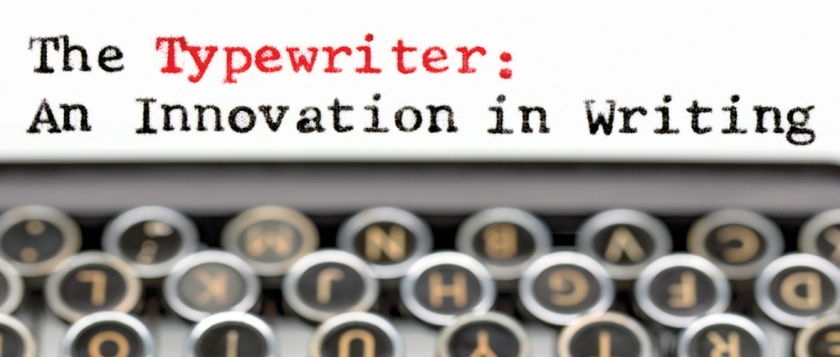

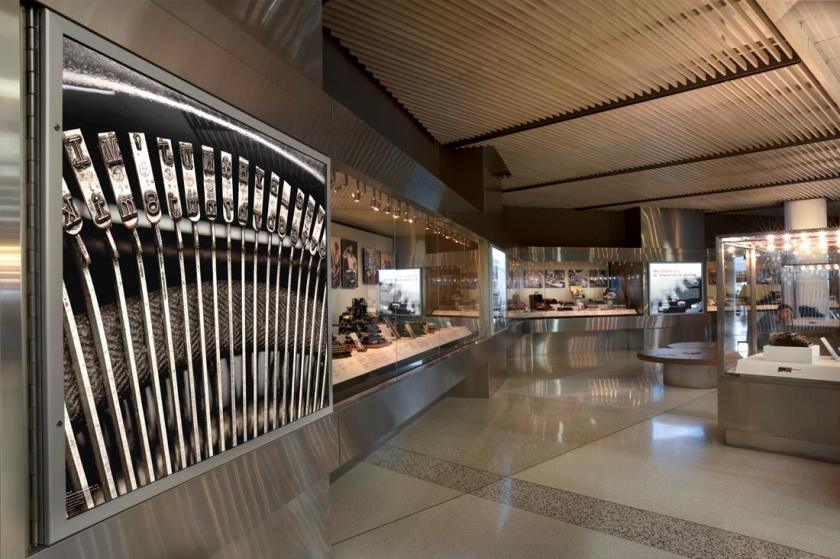
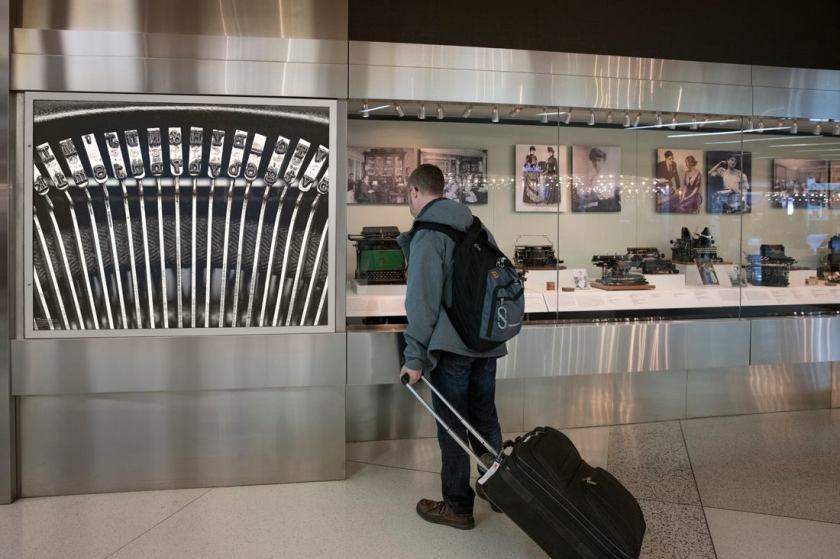
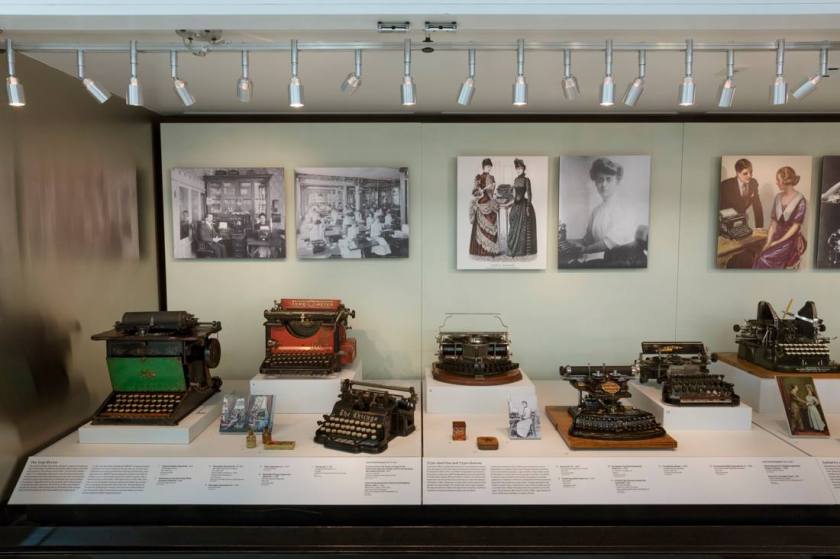
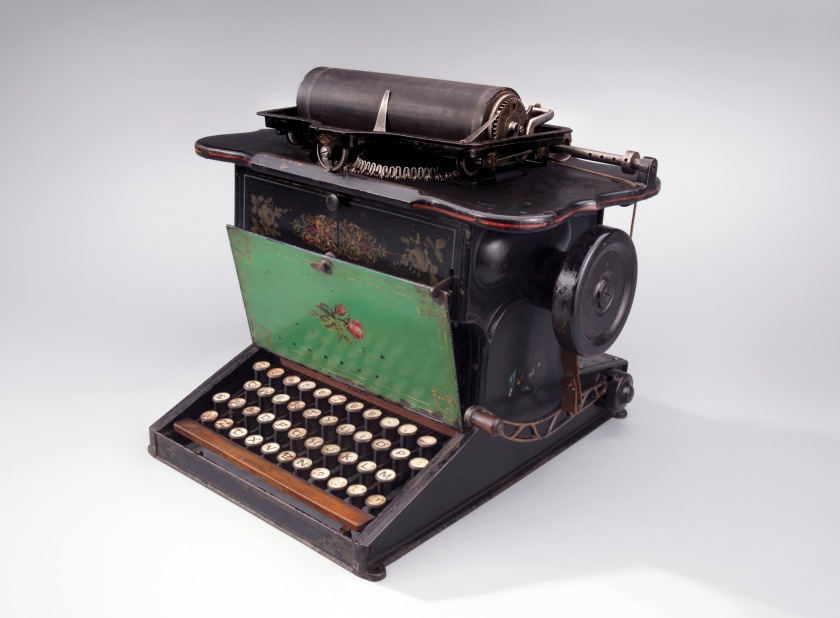

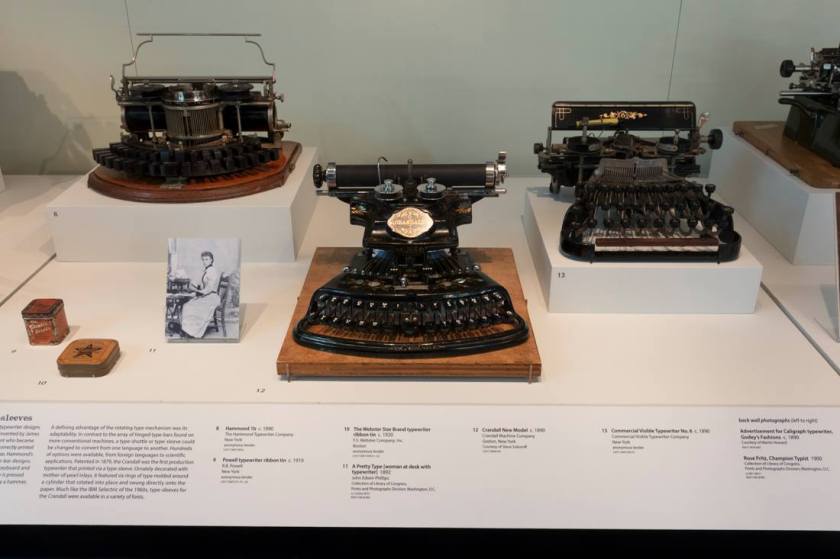



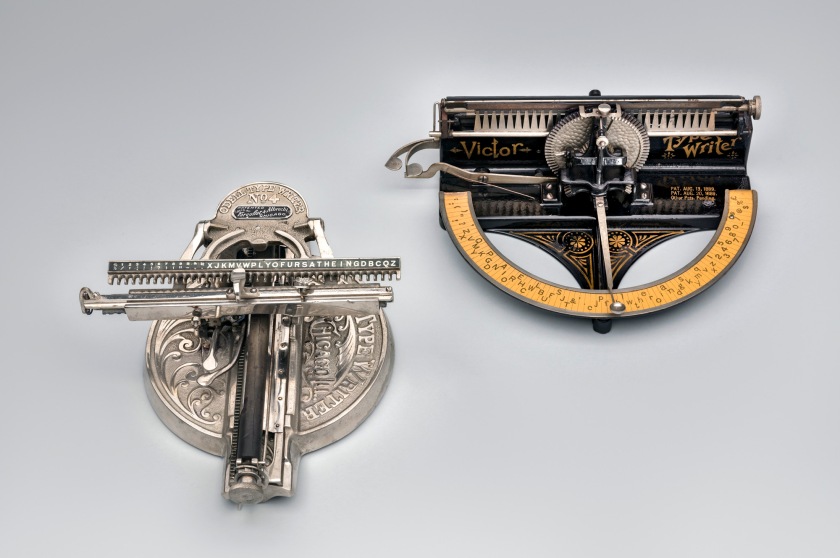
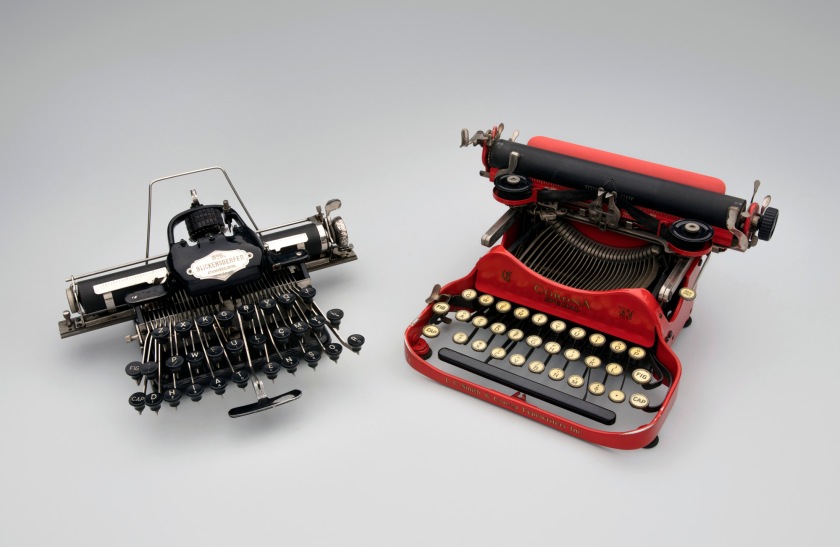

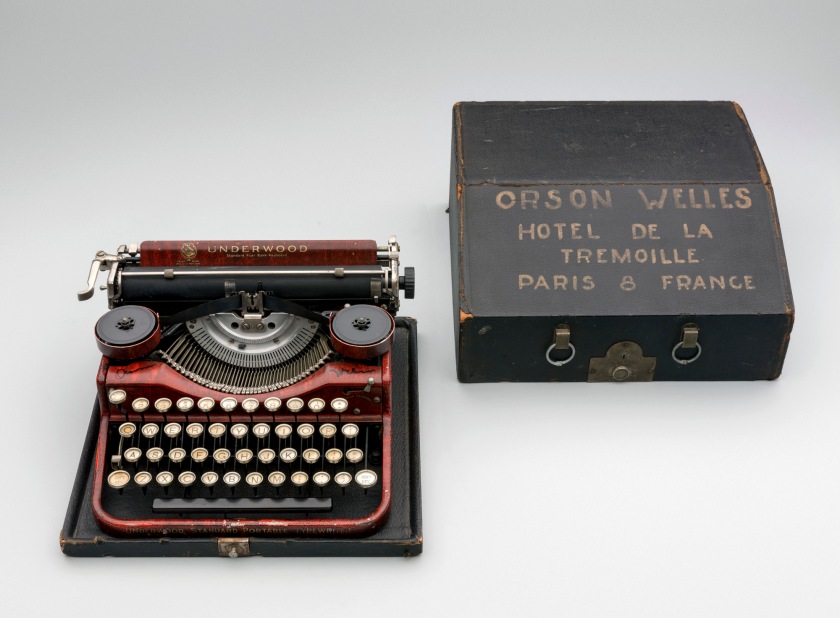
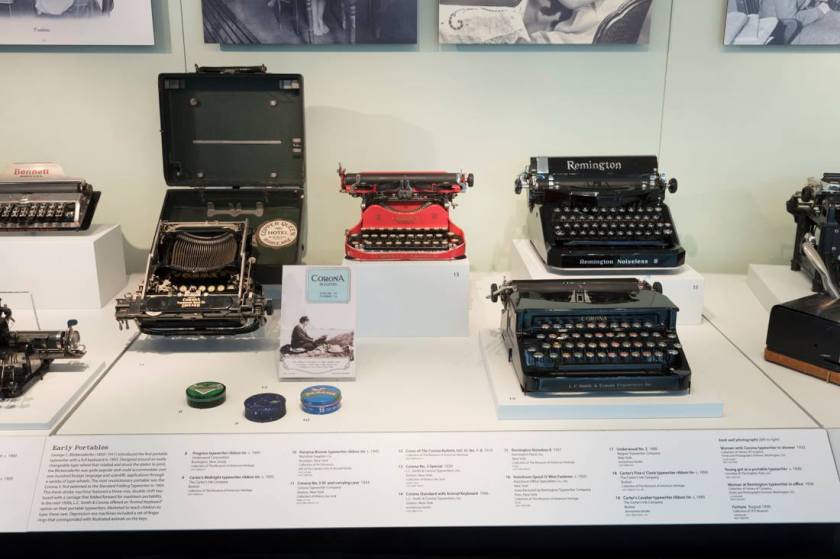
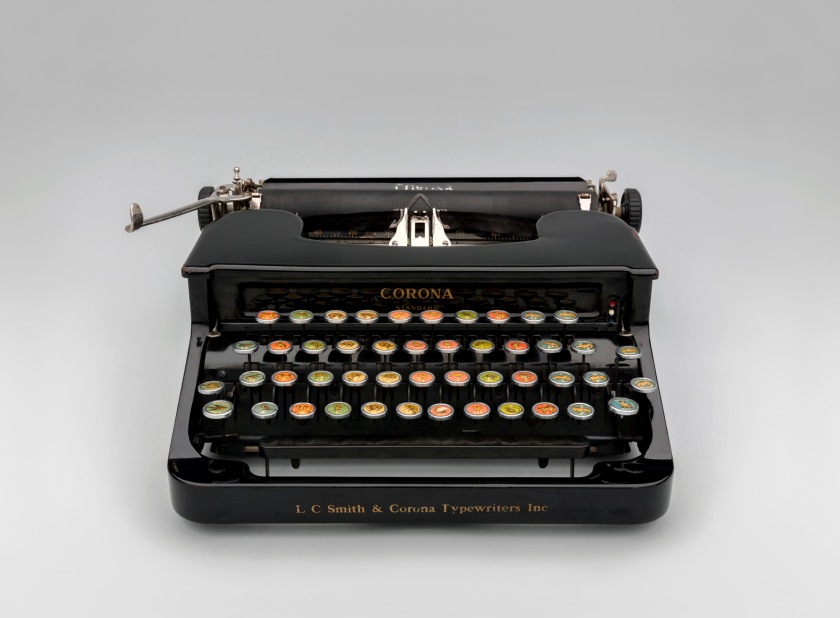
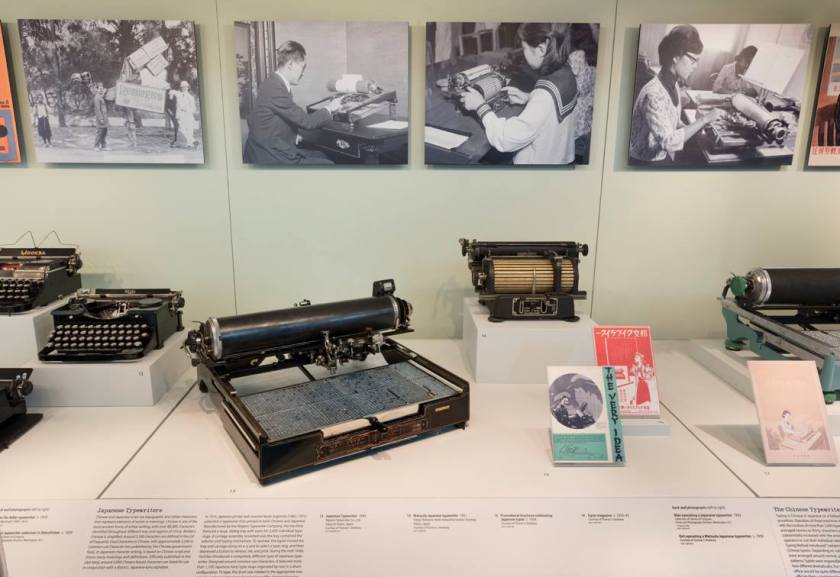
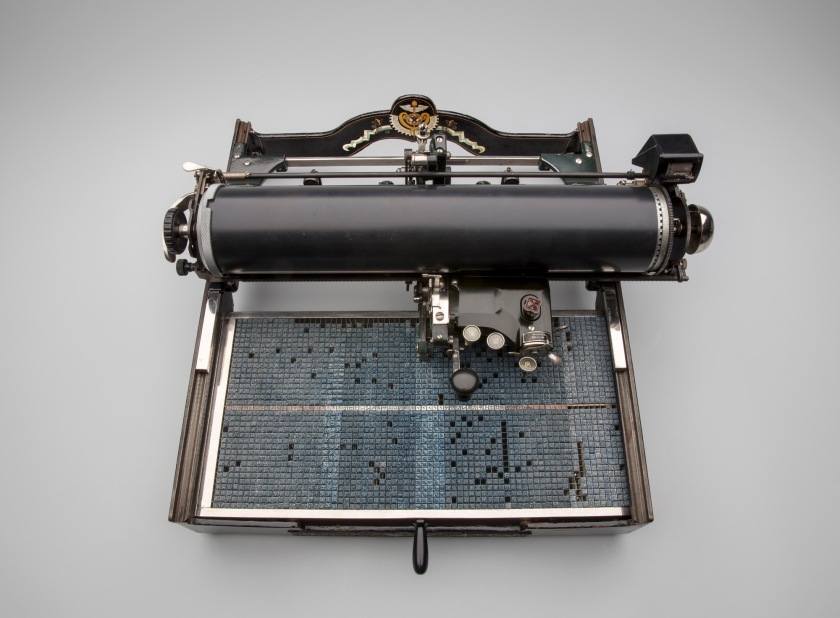


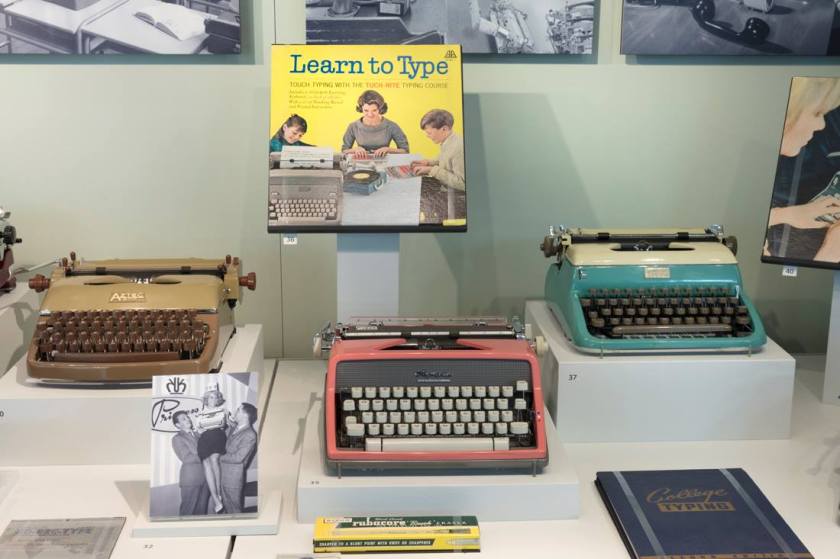
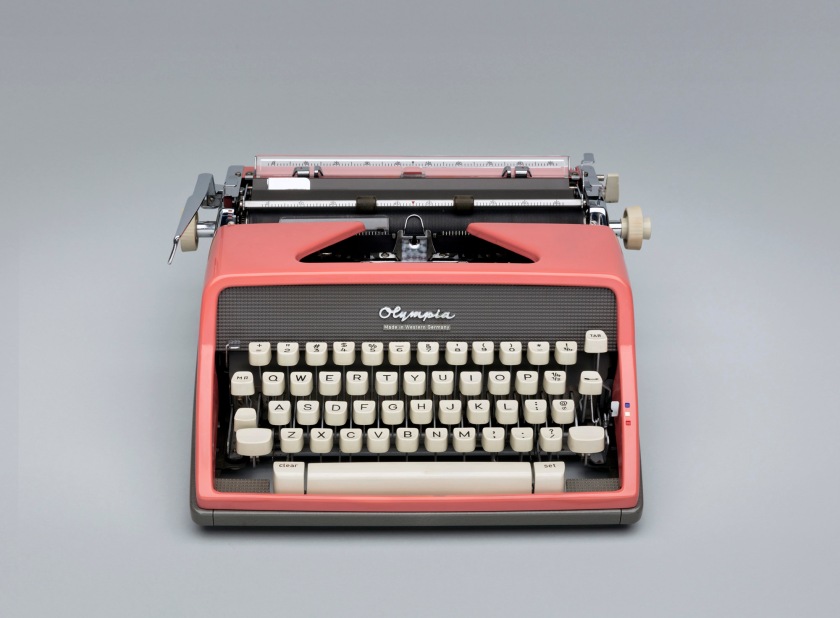

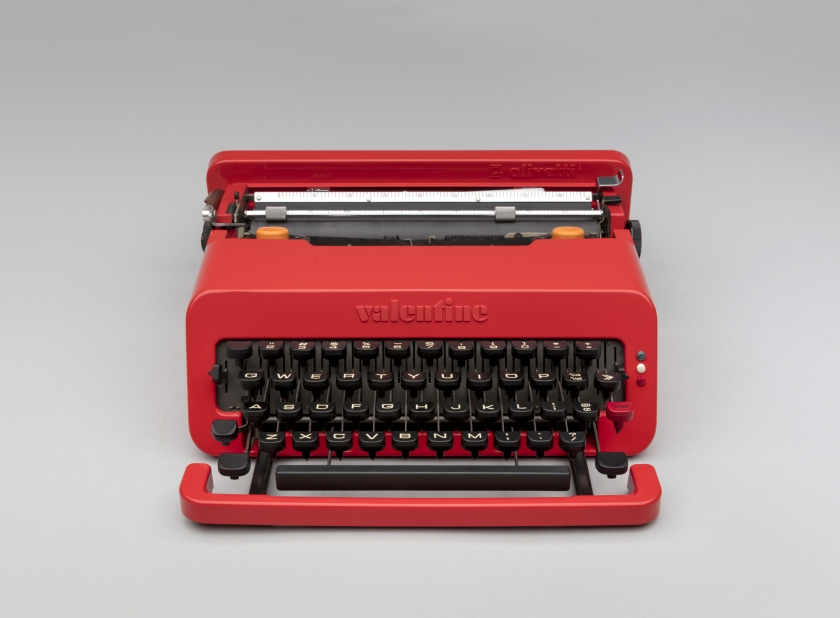
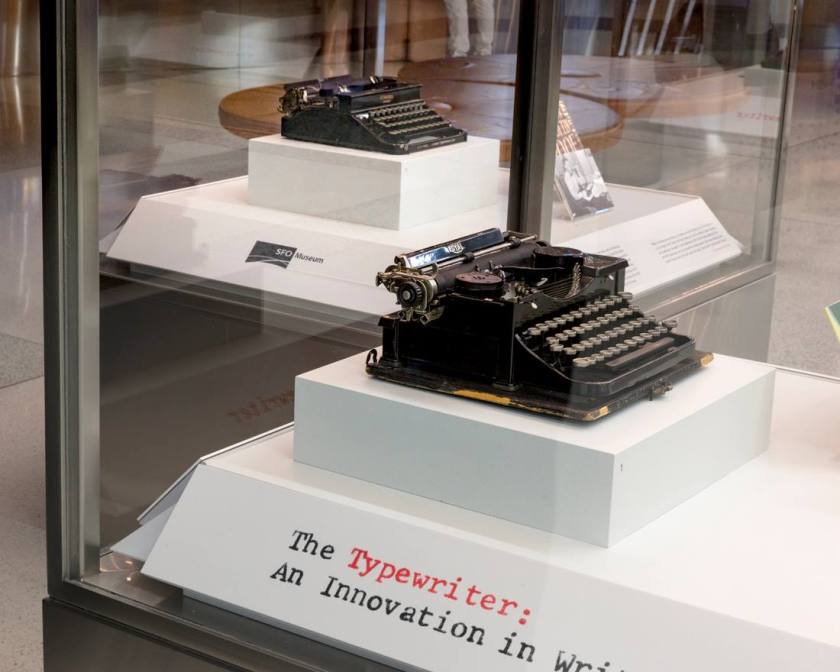



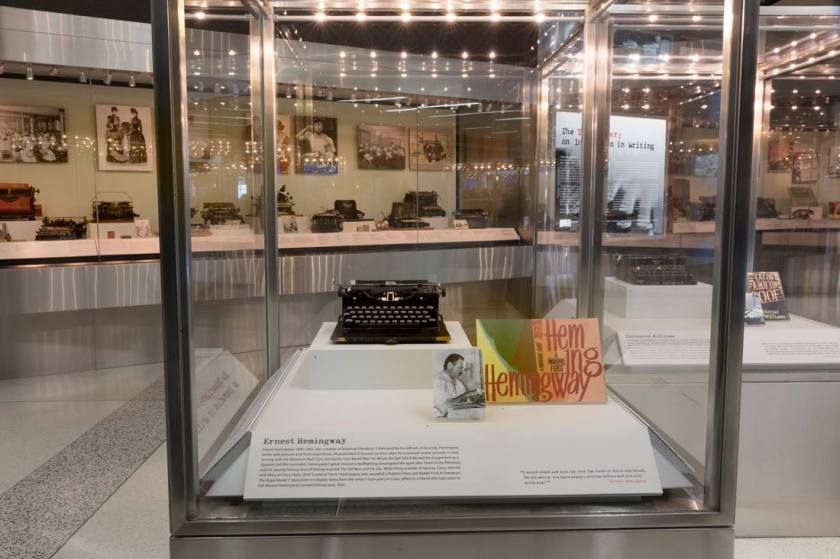





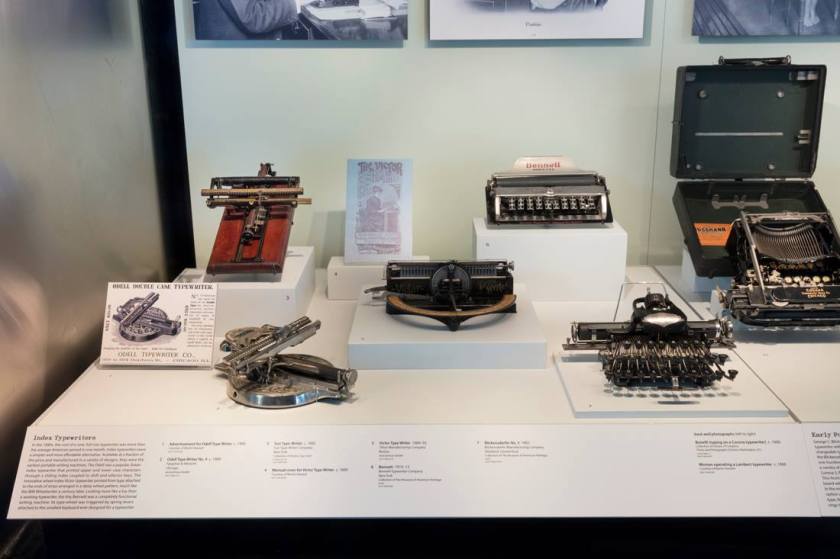
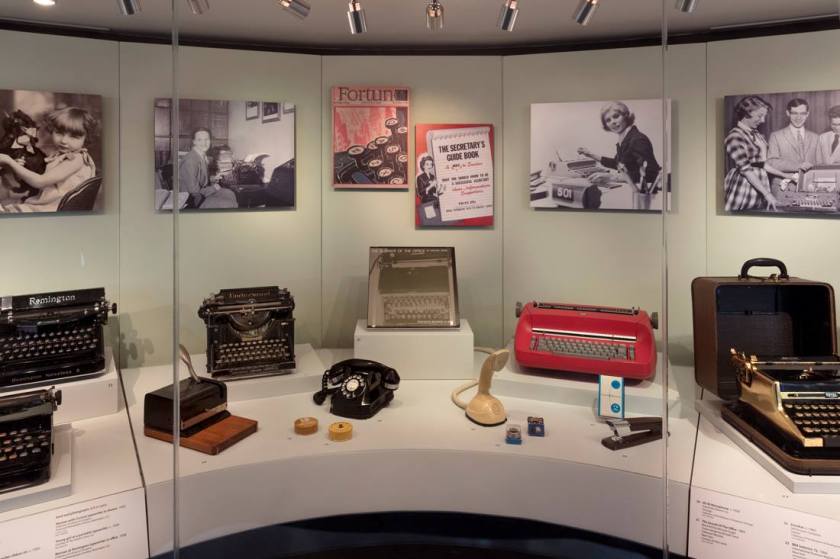

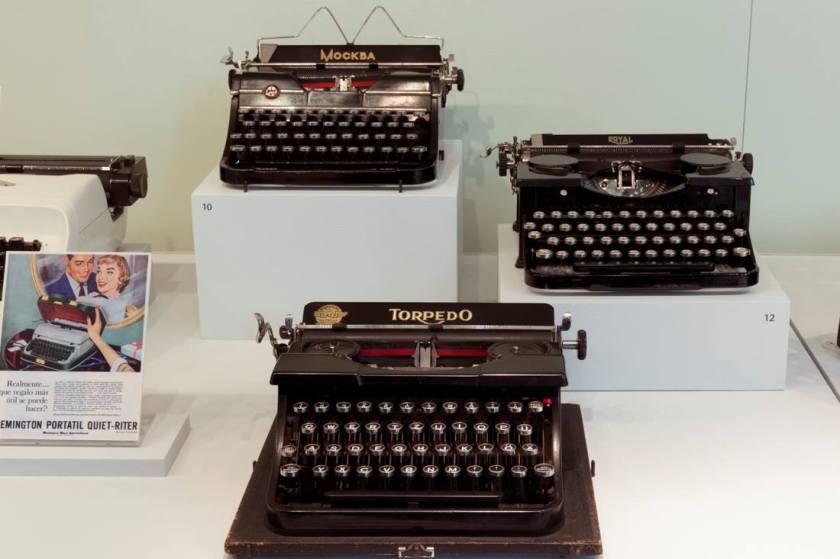
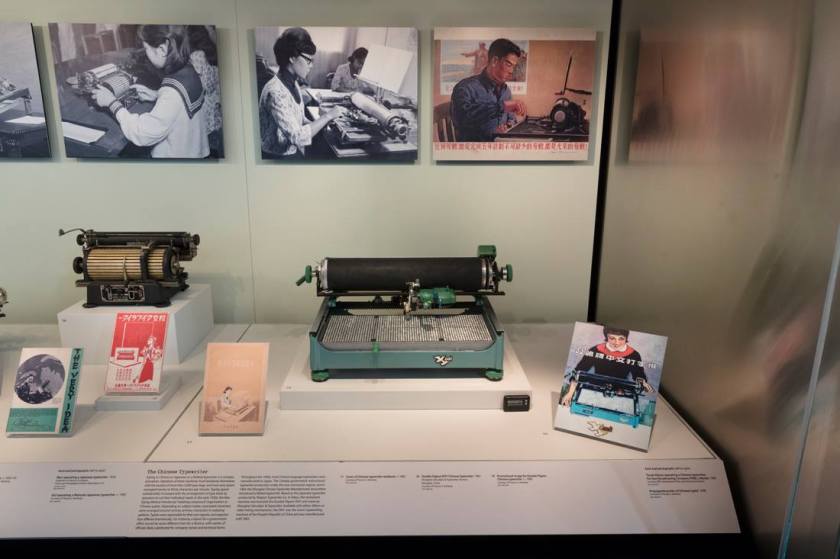
You must be logged in to post a comment.